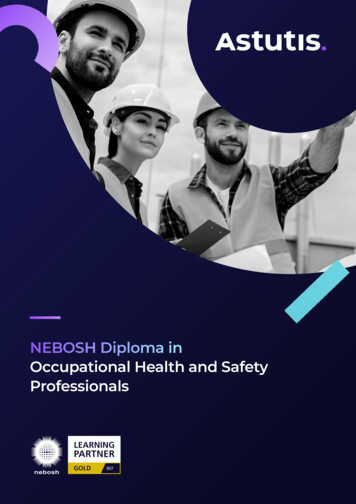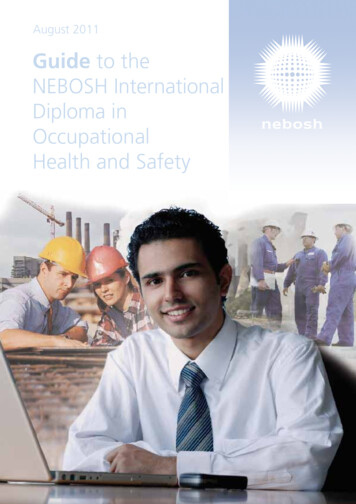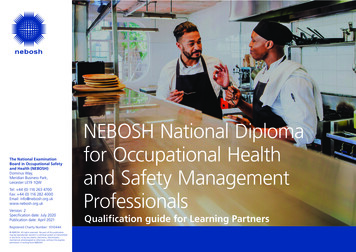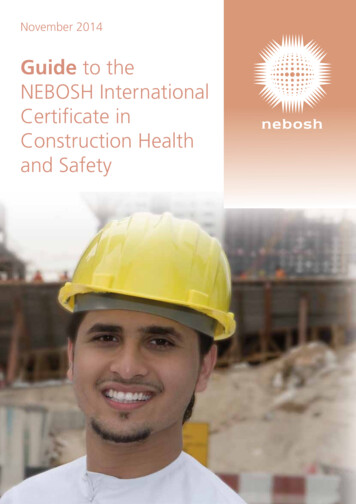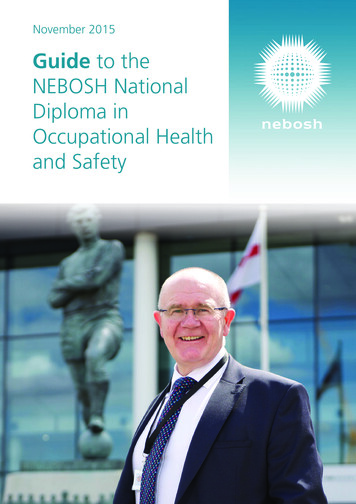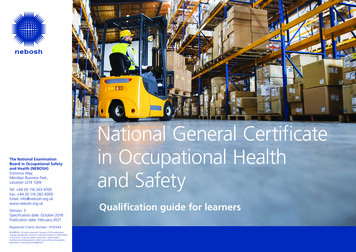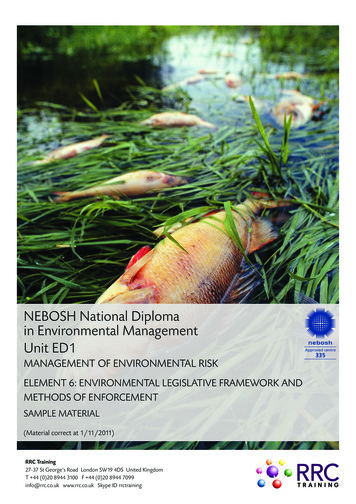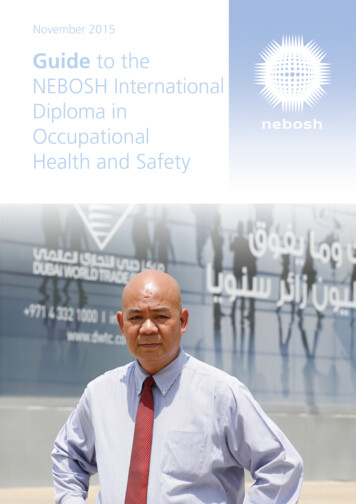
Transcription
November 2015Guide to theNEBOSH InternationalDiploma inOccupationalHealth and Safety
Front cover photograph:Joel NedamoHealth and Safety Adviser, Dubai World Trade CentreAwarded the: NEBOSH International Diploma in Occupational Health andSafety in 2011Qualification title: International Diploma in Occupational Health and SafetyVersion: 4Specification date: November 2015Guide publication date: October 2016The National Examination Board in Occupational Safety and Health (NEBOSH),Dominus Way, Meridian Business Park, Leicester LE19 1QW.Registered Charity Number: 1010444Telephone:Fax:Email:Website: 44 (0) 116 263 4700 44 (0) 116 282 4000info@nebosh.org.ukwww.nebosh.org.uk NEBOSHAll rights reserved. No part of this publication may be reproduced, stored in a retrieval system ortransmitted in any form, or by any means, electronic, electrostatic, mechanical, photocopied orotherwise, without the express permission in writing from NEBOSH. NEBOSH 2016
Guide to the NEBOSH International Diploma in OccupationalHealth and Safety (November 2015 .192.1112223344444555555Qualification structure2.12.22.32.42.52.62.72.83.Benefits for employersDesignatory lettersProfessional membershipQualification level and UK accreditationKey topics coveredCourse tuition and private study time requirementsEntry requirementsMinimum standard of English required for studentsLegislationLegislative updatesNational Occupational Standards (NOS) and best practiceQualification typeQualification progressionProgrammes offered by NEBOSH-accredited course providersExamination datesSpecification dateSyllabus development and reviewFurther information for studentsFurther information for accredited course providersStudent enrolmentUnit assessmentsAssessment setting and markingUnit pass standardsUnit certificatesQualification gradeQualification parchmentRe-sitting unit/s66888889Policies3.13.23.33.4Requests for access arrangements/reasonable adjustmentsRequests for special considerationEnquiries about results and appealsMalpractice NEBOSH 201610101011
4.Notes for tutors4.14.24.34.45.5.1Case studies / past incidentsTutor referencesTeaching of unitsMinimum standard of English required for tutorsSyllabus - NEBOSH International Diploma in Occupational Health and Safety(November 2015 specification)13Unit IA: Managing health and safetyElement IA1: Principles of health and safety managementElement IA2: Regulating health and safetyElement IA3: Loss causation and incident investigationElement IA4: Measuring and reviewing health and safety performanceElement IA5: The assessment and evaluation of riskElement IA6: Risk ControlElement IA7: Organisational factorsElement IA8: Human factorsElement IA9: The role of the health and safety practitionerUnit IA: Tutor ReferencesHealth and safety incidentsInternational statutory instruments (Directives, Conventions,Recommendations and Protocols)Other relevant international referencesOther relevant UK nit IB: Hazardous substances / agentsElement IB1: Managing occupational healthElement IB2: Identification, assessment and evaluation of hazardous substancesElement IB3: The control of hazardous substancesElement IB4: The monitoring and measuring of hazardous substancesElement IB5: Biological agentsElement IB6: Noise and vibrationElement IB7: RadiationElement IB8: Mental ill-health and dealing with violence and aggression at workElement IB9: Musculoskeletal risks and controlsElement IB10: Work environment risks and controlsUnit IB: Tutor ReferencesInternational statutory instruments (Directives, Conventions,Recommendations, Regulations and Protocols)Other relevant international referencesOther relevant UK references NEBOSH 20163840434648505356586062626263
Unit IC:Workplace and work equipment safetyElement IC1: Workplace welfare requirements and specific workplace issuesElement IC2: Fire and explosionElement IC3: Workplace fire risk assessmentElement IC4: The storage, handling and processing of dangerous substancesElement IC5: Work equipmentElement IC6: Workplace machineryElement IC7: Mobile, lifting, access and work at height equipmentElement IC8: Electrical safetyElement IC9: Construction and works of a temporary nature - hazards and controlsElement IC10: Workplace transport and managing work-related road riskUnit IC: Tutor ReferencesHealth and safety incidentsInternational statutory instruments (Directives, Conventions,Recommendations and Protocols)Other relevant international referencesOther relevant UK references5.4 Unit DNI: Application of health and safety in the workplace5.Sample question papers5.1 Unit IA: Managing health and safety5.2 Unit IB: Hazardous substances / agents5.3 Unit IC: Workplace and work equipment safety NEBOSH 2016666870727476788082848686868787909296100
The Guide to the NEBOSH International Diploma in Occupational Health and Safety(November 2015 specification)1.IntroductionThe NEBOSH International Diploma is a qualification for aspiring health and safetyprofessionals, building directly upon the foundation of knowledge provided by the NEBOSHInternational General Certificate in Occupational Health and Safety. The Diploma is designedto provide students with the expertise required to undertake a career as a health and safetypractitioner and also provides a sound basis for progression to postgraduate study.The International Diploma is modelled on the NEBOSH National Diploma in OccupationalHealth and Safety. The key difference between the two qualifications is in the applicability oflegal requirements. Rather than be guided by a specifically UK framework, the InternationalDiploma takes a risk management approach based on best practice and internationalstandards, such as International Labour Organisation (ILO) codes of practice. Local laws andcultural factors form part of the study programme where relevant and appropriate.1.1Benefits for employersDespite the increasing global recognition of the importance of health and safety at work,accidents and work-related ill-health continue to affect all types of workplaces andoccupations. The ILO estimates that 6,300 people die daily as a result of occupationalaccidents or work-related diseases - more than 2.3 million deaths worldwide per year. At least10% of these deaths are due to the 337 million accidents at work that occur annually. Thereare an estimated 500 –2000 non-fatal injuries for every fatal injury (including 160 million casesof work-related disease), many of which result in lost earnings, lost jobs and permanentdisability and poverty.In addition to the direct costs of sick pay and absence, employers can find themselves dealingwith criminal prosecution, claims for compensation, adverse publicity and harm to bothbusiness reputation and profitability. In the UK economy alone, the estimated annual cost ofoccupational injury and illness in 2014/15 is 14.3 billion.The vast majority of workplace injuries, accidents and ill-health are avoidable by good healthand safety management; it makes good business sense. Qualified health and safetyprofessionals are an asset to their organisation; they can help to reduce costs by preventingaccidents and ill health of employees, without incurring unnecessary expense by over-reactingto trivial risks. This in turn can lead to improved productivity and raising workforce morale.Effective health and safety management should, therefore, be recognised as an essentialelement of a successful management strategy.Courses leading to the NEBOSH International Diploma may be taken in a variety of formatsand at a pace to fit around the needs of the business. Its unitised structure recognises successas the student progresses. Its practical approach promotes the application of the knowledgeacquired on the course to problem solving in the student’s own workplace.1.2Designatory lettersHolders of the NEBOSH International Diploma in Occupational Health and Safety may usethe designatory letters ‘IDipNEBOSH’ after their name.1.3Professional membershipThe qualification meets the academic requirements for application for Graduate Membership(Grad IOSH) of the Institution of Occupational Safety and Health (IOSH – www.iosh.co.uk). NEBOSH 20161
The Guide to the NEBOSH International Diploma in Occupational Health and Safety(November 2015 specification)This is the first step to becoming a Chartered Health and Safety Practitioner as a CharteredMember of IOSH (CMIOSH).Holders of the International Diploma are able to waive the Board of Certified SafetyProfessionals’ Associate Safety Professional (ASP) examination so that, if they meet all otherrequirements, they may sit directly for the Certified Safety Professional (CSP) examination.Holders of the NEBOSH International Diploma in Occupational Health and Safety and eitherthe NEBOSH National or International Certificate in Construction Health and Safety meet theheadline entrance criteria requirements for Registered Construction Safety Practitioner(RMaPS) and membership of the Association for Project Safety (APS).The International Diploma is also accepted by the International Institute of Risk and SafetyManagement (IIRSM) as meeting the academic requirements for full membership (MIIRSM).1.4Qualification level and UK accreditationNEBOSH is intending to apply for the NEBOSH International Diploma in Occupational Healthand Safety (November 2015 specification) to be accredited and credit rated by the ScottishQualifications Authority (SQA - www.sqa.org.uk) for delivery across the UK. The August 2011specification is rated within the Scottish Credit and Qualifications Framework (SCQF www.scqf.org.uk) at SCQF Level 10 with 47 SCQF credit points. It is anticipated that therevised November 2015 specification will be at the same level with 48 credits.For users in England, Wales and Northern Ireland, this is comparable to a VocationallyRelated Qualification (VRQ) at Level 6 within the Regulated Qualifications Framework (RQF)and Qualifications and Credit Framework (QCF), or Honours Degree standard.For further information please refer to the “Qualifications can cross boundaries” comparisonchart issued by the UK regulators, available from the SQA website (www.sqa.org.uk).1.5Key topics covered Managing health and safety Hazardous agents in the workplace Workplace and work equipment safety Practical application of health and safety theory1.6Course tuition and private study time requirementsUnit IA: 86 hours tuition and 68 hours private studyUnit IB: 65 hours tuition and 50 hours private studyUnit IC: 70 hours tuition and 50 hours private studyUnit DNI: 5 hours tuition and 72 hours private studyTotal: 154 hoursTotal: 115 hoursTotal: 120 hoursTotal: 77 hoursA programme of study therefore needs to be based around a minimum of 226 taught hoursand approximately 240 hours of private study for an overall total of 466 Hours.A full-time block release course would be expected to last for a minimum of 33-working daysand a part-time day release course would be spread over at least 33-weeks. The tuition hours NEBOSH 20162
The Guide to the NEBOSH International Diploma in Occupational Health and Safety(November 2015 specification)should be added to the recommended private study hours to give the minimum number ofhours for students studying by open or distance learning.Tuition time should normally be allocated proportionate to the tuition time for each element butmay require adjustment to reflect the needs of a particular student group.Quoted hours do not include assessment time, ie, sitting written examinations.1.7Entry requirementsThe NEBOSH International Diploma syllabus assumes that students will have knowledge ofhealth and safety equivalent to that provided by the NEBOSH International General Certificate(IGC).The achievement of the IGC or direct equivalent prior to undertaking the Diplomacourse is highly recommended, because of the demands of high level study, the timecommitment required and the complementary nature of the NEBOSH IGC andInternational Diploma. Further information on the NEBOSH National General Certificate canbe found via our website www.nebosh.org.uk.It should be noted that currently the assessments are offered, and must be answered, inEnglish only. The qualification includes a requirement to write an extended assignment basedon the student’s own workplace, which must also be in English. Students should discuss thisrequirement with the accredited course provider before undertaking the qualification.Students must satisfy any entry requirements specified by the course provider. Acceptanceon to the programme may be based on the admission tutor’s judgement on the student’s abilityto benefit from the programme.1.8Minimum standard of English required for studentsThe standard of English required by students studying for the NEBOSH International Diplomamust be such that they can both understand and articulate the concepts contained in thesyllabus. It is important to stress that it is the responsibility of accredited course providers todetermine their students’ standards of proficiency in English.NEBOSH recommends that students undertaking this qualification should reach a minimumstandard of English equivalent to an International English Language Testing System score of7.0 or higher in order to be accepted onto an International Diploma programme.For further information please see the latest version of the IELTS Handbook or consult theIELTS website: http://www.ielts.org/institutions/test format and results.aspx.Students wishing to assess their own language expertise may consult the IELTS website forinformation on taking the test: http://www.ielts.org/faqs.aspx. NEBOSH 20163
The Guide to the NEBOSH International Diploma in Occupational Health and Safety(November 2015 specification)1.9LegislationThe syllabus refers to international conventions and recommendations. Where thisqualification is delivered overseas, accredited course providers may refer to examples of locallegislation as part of the course programme but examination questions will not refer to specificlegislation, but will refer to International conventions, recommendations and good practice asindicated in the syllabus.1.10 Legislative updatesRelevant new international conventions and recommendations will become examinable indetail six months after their date of introduction. However, students will be expected to beessentially up-to-date at the time of the examination and, whilst a detailed knowledge will notbe expected, reference to new or impending international conventions and recommendations,where relevant to an examination question, will be given credit.Please note, NEBOSH will not ask questions related to international conventions andrecommendations that have been repealed, revoked or otherwise superseded.NB: Accredited course providers are expected to ensure their course notes remain currentwith regard to new international conventions and recommendations.1.11 National Occupational Standards (NOS) and best practiceThe syllabus is mapped to the relevant National Occupational Standard (NOS). The mappingof the syllabus units to each NOS can be found on pages 13-16.1.12 Qualification typeNEBOSH qualifications are categorised as 'Other’ qualifications by SQA Accreditation inScotland. These are categorised as Vocationally-Related Qualifications (VRQs) in England,Wales and Northern Ireland.VRQs provide the knowledge and practical skills required for particular job roles through astructured study-based training programme, that combine the testing of knowledge andunderstanding in written examinations with practical application of learning in the workplace.VRQs are a popular type of qualification because they are nationally recognised, flexible andoffer routes for progression to employment or further study.1.13 Qualification progressionStudents who wish to continue their studies in the UK may wish to consider the NEBOSHNational Diploma in Occupational Health and Safety. Unit DNI is a ‘common unit’ and formspart of the National and International Diplomas. Therefore, students wish to study the NationalDiploma will only need to pass three additional units to achieve this further qualification.Students who have achieved the NEBOSH International Diploma may be considering furtherhealth and safety study. NEBOSH has entered into partnership with the University of Hull tooffer a range of Masters Degrees. NEBOSH 20164
The Guide to the NEBOSH International Diploma in Occupational Health and Safety(November 2015 specification)A number of other universities offer MSc programs which accept the NEBOSH Diploma as afull or partial entry requirement.Some MSc courses may require additionalqualifications/expertise such as a degree, further significant work experience or expectstudents to complete specific modules eg, in environmental management.Further information can be found on our website: www.nebosh.org.uk/qualifications1.14 Programmes offered by NEBOSH-accredited course providersAccredited course providers can be located using the ‘Where to study’ tab on our website:www.nebosh.org.ukNB: Students are advised to check up-to-date information on course dates directly withaccredited course providers. It is also recommended that students only accredited courseproviders which appear on the NEBOSH website; this ensures that those accredited courseproviders have met NEBOSH’s quality standards.1.15 Examination dates‘Standard’ examination dates for this qualification are available annually in January and July. UnitDNI assignment submission dates are available annually in February, May, August andNovember.‘On-demand’ examinations are not available for this qualification.1.16 Specification dateThe November 2015 specification for this qualification replaces the previous February 2010specification for all examinations from (and including) January 2017.1.17 Syllabus development and reviewThe syllabus has been developed by NEBOSH following extensive consultation with keystakeholders, notably previous Diploma students, accredited course providers, professionalbodies, employers, standards setting organisations, enforcement bodies and subject experts.NEBOSH would like to take this opportunity to thank all those who participated in thedevelopment, piloting and implementation of this qualification.1.18 Further information for studentsFurther information for students, including a qualification overview leaflet and a sampleexaminers’ report, can be found via the NEBOSH website (www.nebosh.org.uk).1.19 Further information for accredited course providersFurther information for accredited course providers, including policies and procedures andguidance regarding the Unit DNI assignment, can be found in the accredited course providers’section of the NEBOSH website. NEBOSH 20165
The Guide to the NEBOSH International Diploma in Occupational Health and Safety(November 2015 specification)2.Qualification structure2.1Student enrolment At the start of their studies, students will enrol with NEBOSH. The enrolment period is 5years. On completion of the first successful unit, the enrolment start date will change to the sameas the declaration date (the date which appears on the unit certificate) of the successfulunit. The student will then have 5-years from this new date to achieve the qualification. All units will have a 5-year validity period. Units which are older than 5-years will no longerbe valid and will not count towards the qualification grading. Any such unit/s will need tobe retaken by the student to allow the student to complete the qualification. Once the oldest unit is no longer valid ie it is 5 or more years older than the current date,the enrolment start date will move to the declaration date of the second successful unit. The student’s enrolment period will end:o when the student has successfully completed all 4 units; oro when all successful units have expired (ie the declaration date/s are 5 or more yearsolder than the current date; oro 5-years from the enrolment start date if the student has not attempted any unitassessment; oro 5-years from the enrolment start date if unit assessment/s have been attempted butthe student has received a ‘Refer’ result and/or has been marked as ‘absent’. If a student cannot complete all 4 units within the 5-year completion time-frame they mayapply for a unit validity extension for each affected unit. Please refer to the ‘EnrolmentPolicy for NEBOSH Diploma Level Qualifications’ for further information.2.2Common unit and exemptionThe NEBOSH National Diploma in Occupational Health and Safety shares a ‘common unit’(Unit DNI) with the NEBOSH International Diploma in Occupational Health and Safety.Students can, therefore, take the assessments for Units IA, IB and IC and they will gain anadditional qualification.The ‘common unit’ can be used as an exemption against the International Diploma inOccupational Health and Safety for up to five years after the declaration date (the date printedon the unit certification) of Unit DNI. Likewise, holders of the International Diploma inOccupational Health and Safety will have five years to use their Unit DNI pass as an exemptionagainst the same unit for the National Diploma in Occupational Health and Safety.2.3Unit assessmentsThe International Diploma in Occupational Health and Safety is divided into four units. Allunits are mandatory and there are no optional units. The student may choose to take the unitstogether or at different times.Unit IA: Managing health and safety Unit IA is a taught unit which is assessed by a 3-hour written examination NEBOSH 20166
The Guide to the NEBOSH International Diploma in Occupational Health and Safety(November 2015 specification) The written examination consists of 11 questions split into Section A and Section B Section A consists of 6 ‘short-answer’ questions (10 marks each) – all questions arecompulsory Section B consists of 5 ‘long-answer’ questions (20 marks each) – the student answers 3out of the 5 questions There is a total of 120 marks available for the paper; the total mark for the paper (SectionA Section B) will then be converted to a percentage Student scripts are marked by external examiners appointed by NEBOSH A sample examination question paper can be found in Section 6.Unit IB: Hazardous substances/agents Unit IB is a taught unit which is assessed by a 3-hour written examination The written examination consists of 11 questions split into Section A and Section B Section A consists of 6 ‘short-answer’ questions (10 marks each) – all questions arecompulsory Section B consists of 5 ‘long-answer’ questions (20 marks each) – the student answers 3out of the 5 questions There is a total of 120 marks available for the paper; the total mark for the paper (SectionA Section B) will then be converted to a percentage Student scripts are marked by external examiners appointed by NEBOSH A sample examination question paper can be found in Section 6.Unit IC: Workplace and work equipment safety Unit IC is a taught unit which is assessed by a 3-hour written examination The written examination consists of 11 questions split into Section A and Section B Section A consists of 6 ‘short-answer’ questions (10 marks each) – all questions arecompulsory Section B consists of 5 ‘long-answer’ questions (20 marks each) – the student answers 3out of the 5 questions There is a total of 120 marks available for the paper; the total mark for the paper (SectionA Section B) will then be converted to a percentage Student scripts are marked by external examiners appointed by NEBOSH A sample examination question paper can be found in Section 6.Unit DNI: Application of health and safety management in the workplace Unit DNI consists of a written assignment set by NEBOSH The report should be approximately 8000 words in total, excluding the references,bibliography and appendices. No penalty will be applied to reports which exceed 8000words but students should aim to keep their word count under 12000 NEBOSH 20167
The Guide to the NEBOSH International Diploma in Occupational Health and Safety(November 2015 specification) Submission dates for Diploma assignments are in February, May, August and Novembereach year The assignment is marked by external examiners appointed by NEBOSH.2.4Assessment setting and markingNEBOSH applies best practise in relation to assessment setting and marking. NEBOSH usesexternal assessment for written examinations and assignments: scripts are sent to NEBOSHand undergo rigorous marking, checking and results determination processes to ensureaccuracy and consistency.2.5Unit pass standardsThe pass standard for each unit may vary according to pre-determined criteria but is normalisedto 45% for the written papers (Units IA, IB and IC) and 50% for the assignment unit (Unit DNI).2.6Unit certificatesStudents who are successful in an individual unit will be issued with a unit certificate, normallywithin 40 working-days of the issue of the unit result notification. Units are not graded and theunit certificates will show a ‘Pass’ only.2.7Qualification gradeWhen students have been awarded a unit certificate for all four units (ie, have achieved a Passin units IA, IB, IC and DNI), the percentage achieved for each of the units are added togetherand a final grade is awarded as follows:DistinctionCreditPass2.8280 or more240 – 279185 – 239Qualification parchmentOnce a student has achieved a ‘Pass’ in all four units and the qualification grade has beenawarded they are normally considered to have completed the qualification. A qualificationparchment will be issued within 40 working-days of the unit result declaration date for thefourth successfully completed unit.However, once the result of the fourth successfully completed unit has been issued the studenthas 20 working-days from the date of issue of that result to either: Inform NEBOSH in writing of their intention to re-sit a successful unit for the purposes ofimproving a gradeSubmit an Enquiry About Result (EAR) request (see Section 3.3). NEBOSH 20168
The Guide to the NEBOSH International Diploma in Occupational Health and Safety(November 2015 specification)2.9Re-sitting unit/sIf a student’s performance in any unit is lower than a ‘Pass’, the student may re-sit the unit/sin which they have been unsuccessful providing that this happens within the 5-year completionperiod. However, each re-sit will incur an additional fee.Students may re-sit units at any time within their enrolment period. This includes re-sittingsuccessful unit/s to try to improve the qualification grade. When all four units have beensuccessfully completed, students will need to inform NEBOSH of their intention to re-sit thesuccessful unit/s within 20 working-days of the date of the results issue for the fourthunit. There is no limit to the number of re-sits which can be taken within the enrolment period.If a re-sit results in a lower mark than a previously declared mark for that unit, the highest markwill be used when calculating the qualification grade.For the Unit DNI assignment, there is no limit to the number of submissions within thecompletion period. If a student gains lower than the pass standard in the assignment, theymay revise and submit the assignment again. However, they must re-register for theassignment in order to do so. Please note that no feedback will be given on the referredassignment and each additional submission will incur a fee. Marks awarded for subsequentsubmissions will not be capped.If a student registers for any unit of the National Diploma whilst awaiting a result from aprevious sitting of an examination that student may not seek a refund of the registration fee ifthey retrospectively claim exemption for that unit except in the case of an Enquiry AboutResult. NEBOSH 20169
The Guide to the NEBOSH International Diploma in Occupational Health and Safety(November 2015 specification)3.Policies3.1Requests for access arrangements/reasonable adjustmentsAccess arrangements and reasonable adjustments are modifications which are approved inadvance of an examination. They allow attainment to be demonstrated by students with eithera permanent or long-term disability or learning difficulty, or temporary disability, illness orindisposition.Accredited course providers must make requests to NEBOSH for access arrangements orreasonable adjustments at least one month before the assessment.For further details see the NEBOSH “Policy and procedures for access arrangements,reasonable adjustments and special consideration” available from the NEBOSH website(www.nebosh.org.uk).3.2Requests for special considerationSpecial consideration is a procedure that may result in an adjustment to the marks of a studentwho has been unable to demonstrate attainment because of temporary illness, injury,indisposition or an unforeseen incident at the time of the assessment.Students who feel they have been disadvantaged due to illness, distraction or any otherreason during the assessment must report this to the invigilator (or the accredited courseprovider in the case of the assignment) before leaving the examination room. They mustrequest that their written statement, together with the invigilator’s comments on the statement,be sent by the accredited course provider to NEBOSH.Requests for special consideration must be made to NEBOSH by the accredited courseprovider as soon as possible and no more than seven working days after the assessment.For further details see the NEBOSH “Policy and procedures on reasonable adjustments andspecial consideration” available from the NEBOSH website (www.nebosh.org.uk).3.3Enquiries about results and appealsNEBOSH applies detailed and thorough procedures to review and check assessment resultsbefore they are issued. This includes a particular review of borderline results. This ensuresthat the decla
The achievement of the IGC or direct equivalent prior to undertaking the Diploma course is highly recommended, because of the demands of high level study, the time commitment required and the complementary nature of the NEBOSH IGC and International Diploma. Further information on the NEBOSH National General Certificate can


